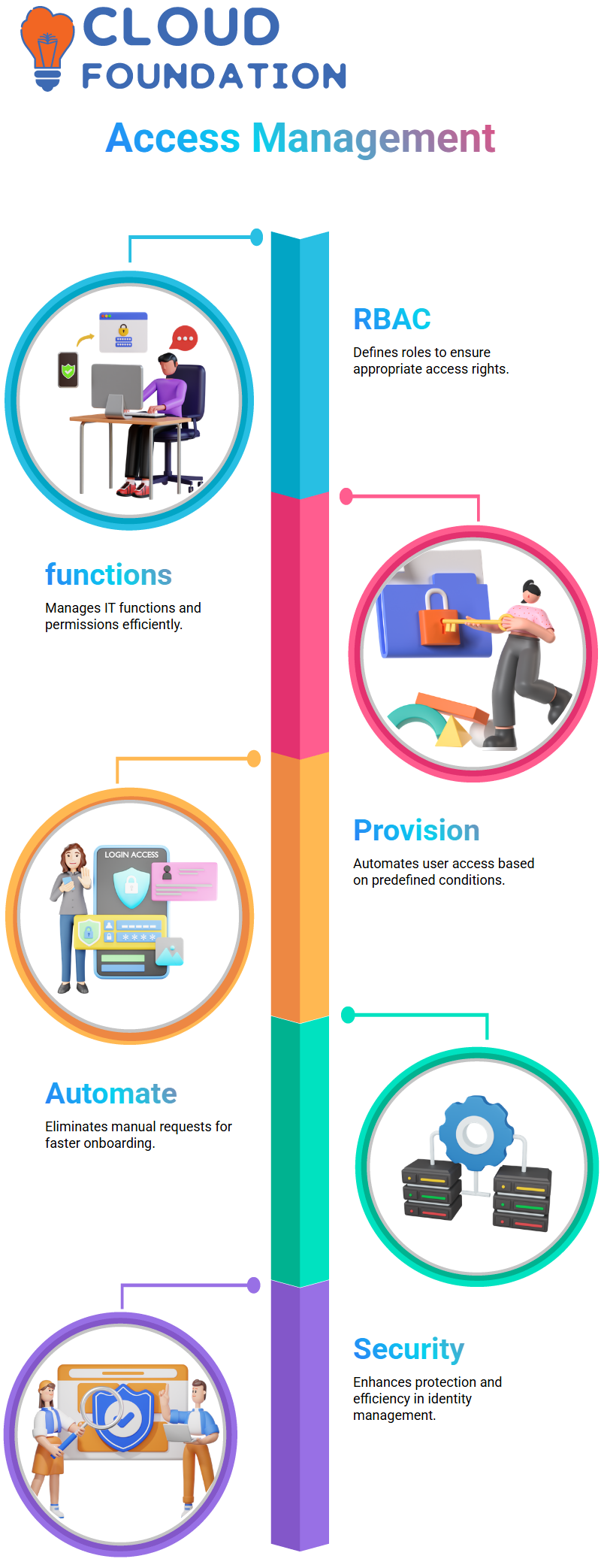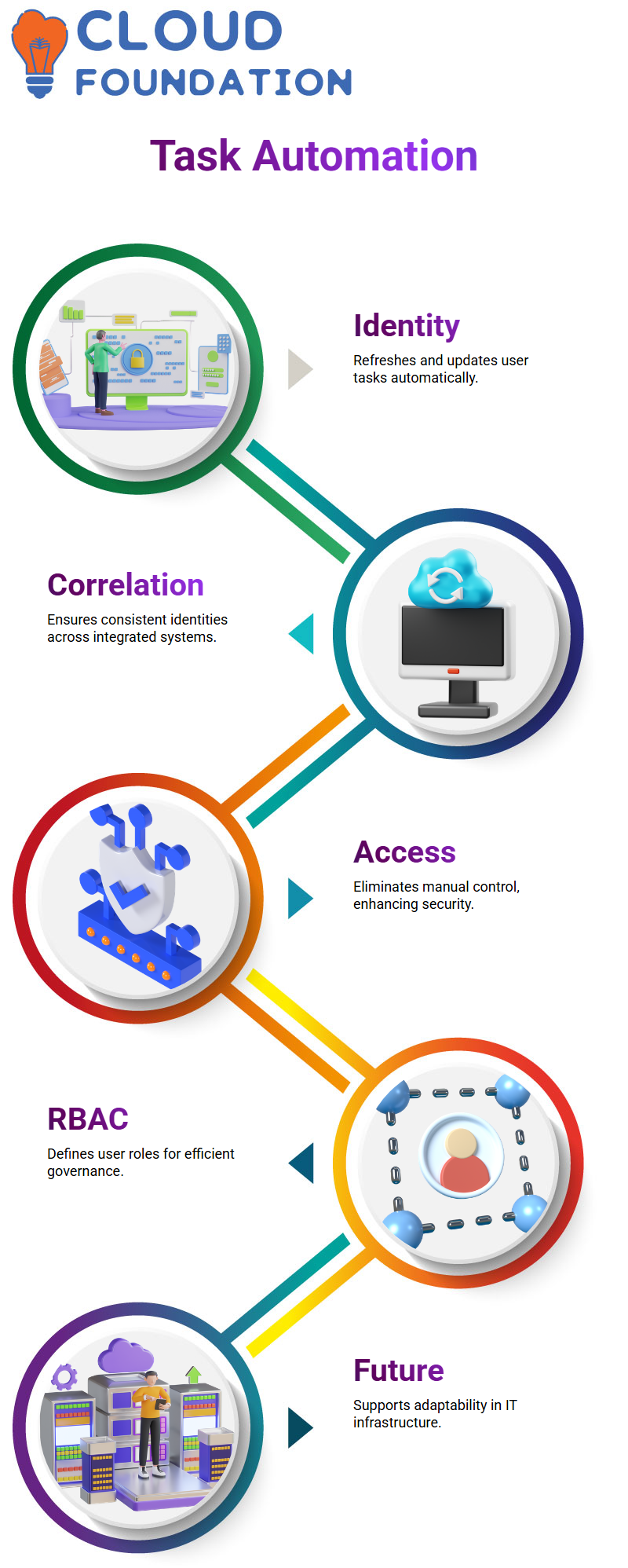SailPoint’s Role-Based Access Control Training Tutorial
What is Role-Based Access Control in SailPoint?
I want to discuss an essential aspect of this solution, specifically the provisioning process in SailPoint.
We have previously discussed the topic of manual provisioning, which involves users requesting access that then undergoes various stages of approval before being granted. Despite that, if we apply automation to the process, what is next?
SailPoint’s automated provisioning ensures that employees are granted the required access even before their first day.
Thus, instead of waiting several days for requests to be approved, SailPoint enables us to set permissions within a process that proceeds according to specific policies, making the process smoother.
This phenomenon is known as birthright provisioning, and it has a significant impact on the situation.
One of the many services that SailPoint provides is a robust identity management solution, enabling organisations to quickly and efficiently allocate user access according to their role, among other services.
SailPoint enables automatic access provision, one of the main ways to ensure that users are given the most appropriate rights.
RBAC ensures that access permissions are updated regularly, based on business tasks and features, thereby preventing unauthorised access and facilitating operational smoothness.

Birthright Access in SailPoint
Birthright access in SailPoint enables employees to obtain their permissions from the very first minute.
It can be established with the help of Role-Based Access Control (RBAC) or activity catalysts, which are commonly referred to as Joiner-Mover-Leaver processes.
RBAC in SailPoint grants access based on job tasks, designations, or the employee’s department. It enables the specification of business capacities, IT tasks, and entitlements for successful onboarding.
For example, a manager may have only the required rights depending on their duties. These assignments can be easily administered through SailPoint directly, thereby facilitating access assignment.
SailPoint Access Manager
SailPoint is an application that provides end-users with the opportunity to work with multiple applications. Initially, users may be assigned to a single application (e.g., PeopleSoft), but later, they can gain additional access based on specific conditions.
PeopleSoft relies on feed files while Prism utilises database structures.
SailPoint can work with both, meaning it can oversee the rigorous role-based access that occurs throughout multiple environments.

SailPoint Identity Manager
SailPoint is a product that simplifies identity and access management. One way that it does this is through role-based access control.
Such a control is executed by clarifying the duties for both users and resources, along with the permissions assigned to each role.
SailPoint ships with a familiar and friendly set of administration objects for standard access and identity management tasks.
In the SailPoint system, identity updates are indispensable for spot-on access rights to remain. Such an update will sanction new provisioning requests that the user has completed, reflecting their business assignments and tasks accordingly.
Administering RBAC in SailPoint
Allow me to guide you through the process of performing RBAC in SailPoint. Initially, we establish business parts that are derived from organisational demands.
These capacities are composed of IT functions, which in turn are comprised of entitlements.
Entitlements represent the clear-cut access rights that certify that users are securing the proper permissions through SailPoint. Administrators can very competently develop and supervise tasks, sustaining respect and security.

Automating Provisioning with SailPoint
Now, whenever the company hires a new worker, SailPoint will automatically grant access and provisioning Policies, instead of requiring manual requests. The rights can be automatically assigned based on predefined conditions.
Automation helps eliminate time waste because employees can start work immediately.
By leveraging SailPoint’s features, businesses can enhance productivity and bolster security simultaneously.
SailPoint Affair Stimuli and Lifecycle Management
Events play a significant role in SailPoint’s identity governance activities. There are many stages of an employee’s lifecycle, such as joining, moving departments, leaving, or even returning, each of which presents an opportunity for concrete identity events to be triggered.
For example, SailPoint responds to new identity creation and performs access granting when an employee joins the organisation.

Similarly, an access update resulting from a manager’s send to another position is made to change the commitments in the proper direction.
Identity Events in SailPoint
Setting up events in SailPoint is not a big deal. The administrators need to identify lifecycle events, such as joining or leaving celebrations, and then select the appropriate provisioning sequence that should be associated with them.
SailPoint uses properties, such as termination date, to determine when a specific action should occur.
By elucidating rules, access can be granted, revoked, or even updated on the fly.
Automating Role Assignments in SailPoint
The best thing about SailPoint’s arrangements is the automation. When a new finance team member joins a company, SailPoint’s AI can automatically specify their business role, provided predefined conditions are met.
As the user’s identity is likely to be imported into SailPoint, the system checks for traits such as department and location once certain conditions are met, and the corresponding role will be provisioned to the user.
SailPoint Task Automation
Once the new identities are generated, SailPoint initiates tasks in line with the schedule to begin the process of refreshing the identity and access control features.
The identity refresh task drives the user tasks update with the transformations in the elements.
Besides, SailPoint can run correlation tasks automatically, ensuring that user identities are consistent and access permissions in integrated applications are uniform.

Why SailPoint is a Game-Changer?
SailPoint once and for all revises the way access is handled in organisations. This means that no more human hands are required to control access, which not only eliminates many security issues but also reduces talent-related legal liabilities.
With the help of access rights belonging to the user (birthright access) and the role-based access control (RBAC), SailPoint excels in two key areas.
First, it facilitates the easy characterisation of identity governance, and second, it addresses the problem of IT infrastructure complexity while maintaining future adaptability.
Workflows and Business Processes in SailPoint
A procedure in SailPoint is a computer-based solution that automates identity and access control tasks.
It is the very procedure that makes the creation of new accounts and the cancellation of permissions so much easier and faster.
A provisioning plan in SailPoint is a set of predefined actions that enable access requests to be managed efficiently. Policy-based provisioning and deprovisioning of functions and data are carried out by these processes.

Business Functions in SailPoint
In the case of business jobs in SailPoint, they specify the required data access levels for specific roles.
A good example of a business role is the Prisma Manager role in SailPoint, where SailPoint ties access rights to the organisation’s needs.
A business role in SailPoint is tied to IT tasks, and IT characters are in turn linked to entitlements. Entitlements refer to the permissions that users are granted within applications.

Navya Chandrika
Author



